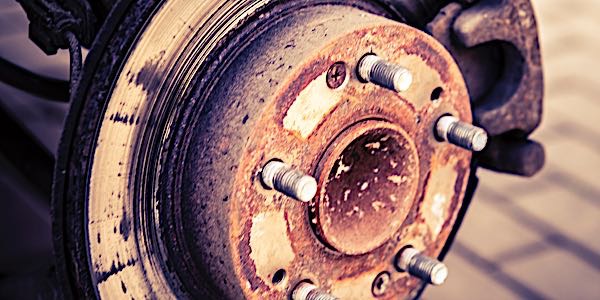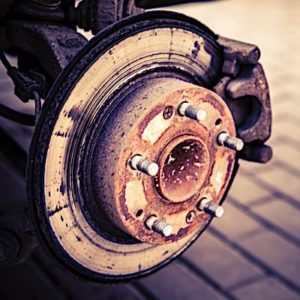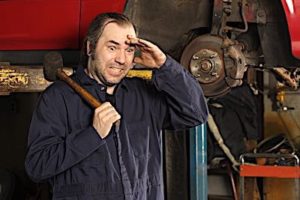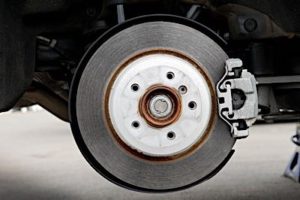Corrosion and rust are nasty problems that make repairing a vehicle difficult. Corrosion is the product of an electrochemical reaction. In a vehicle’s case, between two dissimilar metals and an electrolyte — so, an alloy wheel, a steel bearing hub and saltwater, for example.
Know that there is a difference between corrosion and oxidation. Oxidation is an element combining with oxygen. The process is accelerated by the presence of water and heat. Iron oxidizes to form rust (iron oxide); aluminum oxidizes to form a white powder (aluminum oxide).
The best example of readily visible corrosion is the white or bluish-green stuff that appears on battery connections. The result is that this byproduct either seizes parts into one immovable object or destroys them altogether.
Wheels
A wheel that has seized on a bearing or axle hub can slow down a brake job. Corrosion forms around the hub and wheel. One shop solution is to loosen the lug nuts and spray a penetrating agent on the hub. Maybe try rocking the vehicle from side to side if needed. If the vehicle is on the lift, the solution might be to gently strike the backside of the wheel or tire with a sledgehammer.
Your last resort might be to drive the vehicle slowly 50 to 100 feet and rock the steering wheel from side to side with the lug nuts loose. This typically does not work well for hub-centric wheels.
Heat is not your friend. Using the gas wrench can lead to some not-so-good results. With almost all vehicles coming with alloy wheels, heat and some solvents in penetrating oils might damage the coatings.
If a lug nut will not come off, the best piece of advice for any technician is to invest in special sockets and bits that can remove the lug nut before you run into one of these problems. With lug nuts that have chrome caps, corrosion between the shell and nut can cause swelling. This might cause a socket not to fit or the lug nut to not come out of the socket. There are oversized sockets with an extra .5 mm in the bore for these issues.
Drums and Discs
How do you get a seized drum or rotor off without destroying it and/or ruining the hub or drum flange? The options are penetrating agents, pullers, hammers and heat.
A penetrating agent can’t hurt. They have come a long way in terms of their chemistry and application methods. Penetrants are different than lubricants. Penetrants can get between the surfaces that are rusted — lubricants are designed to simply lubricate.
The hammer was one of humankind’s first tools. When using one to remove a stuck rotor or drum, the primary job of the hammer is not to pound the stuck component off the hub. A hammer should be used to break up the corrosion at the hub. Hammering the areas between the lug studs with an air hammer will often break the drum or rotor so it can be pulled by hand. Hammering on the edge of a rotor or drum will eventually knock a rotor off, but you might damage the backing plate or dust shield.
There have been a lot of tools designed to remove stuck rotors and drums. Most are designed to put force on the rotor while pushing against the lug nuts or flange. These work and are always being refined, so they take less time to set up. Pullers can distort a drum flange on some composite drums.
Heat, which must be used with great caution, does two things. First, it breaks up the corrosion. Second, it causes the components to expand and contract. Getting a rotor or drum cherry red does not guarantee that it will come off.
One type of drum you need to be careful with is the composite drum. Composite drums can be difficult to remove. Often, a stuck drum can be distorted if a great deal of force is used. Cast drums can take a lot of abuse, but always check for cracks.
The composite drum was developed out of a need to reduce the weight of passenger cars and light trucks. The composite drum is produced by stamping a steel flange and placing it into a mold. Molten iron is poured into the mold, and the flange fuses with the molten iron to form the drum. This type is typically found on compact cars.
Corrosion Prevention
Preventing corrosion is near impossible. If you apply any friction-modifying substance, like oil or anti-seize to the wheel stud threads, it is going to change the measured torque values. With less friction on the threads, the torque values increase. The increase in force will mean that the studs will stretch under the increased torque. This stretching can lead to metal fatigue, changes in thread geometry and possible failure.
Many vehicles use the hub to center the wheel. A high-temperature lubricant can be used on these “hub-centric” designs where the hub goes through the center of the wheel. On some conical lug nuts, you can put a light coating on the seating surfaces of the cone, while avoiding any contamination with the threads.

















